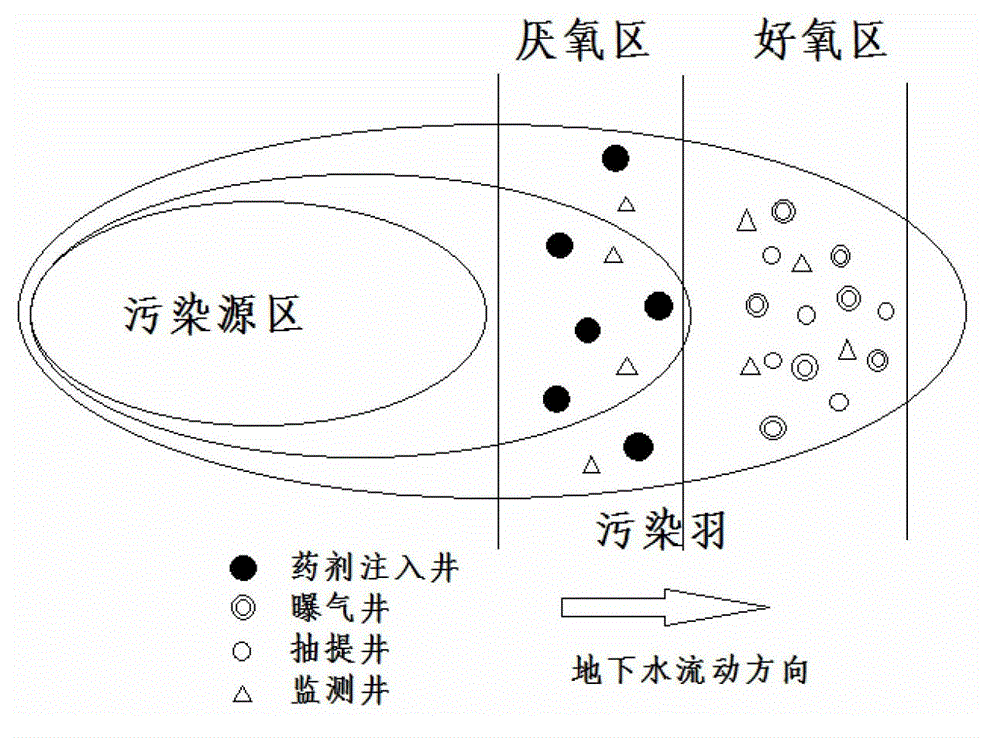Method for in-situ bioremediation of pollution caused by chlorohydrocarbon of underwater
A groundwater pollution and bioremediation technology, applied to water pollutants, chemical instruments and methods, water/sludge/sewage treatment, etc., to achieve low cost, overcome the generation of toxic intermediate products, and maintain safety
- Summary
- Abstract
- Description
- Claims
- Application Information
AI Technical Summary
Problems solved by technology
Method used
Image
Examples
Embodiment 1
[0047] The groundwater at the former site of a factory relocation was polluted by leakage of chlorinated solvents. The length of the pollution plume was 300m, the width was 60m, the groundwater flow rate was 5m / d, and the groundwater level was 6m. The contents of various pollutants in the pollution plume are listed in Table 1.
[0048] Table 1 List of pollutants
[0049] Pollutants
[0050] Such as figure 1 As shown, according to the preliminary survey of the polluted area, the anaerobic remediation area is defined within the range of 150m to 200m from the pollution source in the pollution plume, and the aerobic remediation area is defined within the range of 200m to 250m. In the anaerobic remediation area, 24 drug injection wells and 12 monitoring wells are drilled along the width direction at a distance of 5m, with a depth of 8-15m. The injection agent is a mixed suspension solution of seaweed powder, iron powder and sodium bisulfite with a solid content of 5%. I...
Embodiment 2
[0052] An air force base maintenance plant used a large amount of trichlorethylene as a degreasing agent for a long time in the process of parts processing and modification, and trichlorethylene pollution was detected in the groundwater near the maintenance plant, with a concentration as high as 15.9mg / L. After delineating the anaerobic remediation area and aerobic remediation area within the pollution plume, establish several chemical injection wells, monitoring wells, and aeration wells.
[0053] The composition of the injection agent is a suspension of sucrose, nano-zero-valent iron, and sodium bisulfite with a water content of 80%. In the dry component, sucrose accounts for 40%, nano-zero-valent iron accounts for 50%, and sodium bisulfite accounts for 10%. %. The aeration rate was controlled at about 50mL / min, and after 6 months, the trichlorethylene in the groundwater dropped below 5μg / L, reaching the drinking water standard.
Embodiment 3
[0055] A leakage incident occurred in the tetrachlorethylene storage tank of a factory. After the surface cleaning was completed, it was found that tetrachlorethylene appeared in the groundwater with a concentration of 10mg / L. The contaminated area is about 5m long and 1.6m wide. An anaerobic reaction zone is established centering on the pollution source area. Due to the small pollution area, the dissolved oxygen in the surrounding groundwater can naturally form an aerobic reaction zone.
[0056] The composition of the injection agent is a mixture of vegetable oil with a water content of 70%, sodium dithionite, and nano-zinc powder. In the components, vegetable oil accounts for 50%, sodium dithionite accounts for 20%, and nano-zinc powder accounts for 30%. Three months later, the content of tetrachlorethylene in groundwater dropped below 10 μg / L.
PUM
| Property | Measurement | Unit |
|---|---|---|
| Length | aaaaa | aaaaa |
| Width | aaaaa | aaaaa |
Abstract
Description
Claims
Application Information
 Login to View More
Login to View More - R&D
- Intellectual Property
- Life Sciences
- Materials
- Tech Scout
- Unparalleled Data Quality
- Higher Quality Content
- 60% Fewer Hallucinations
Browse by: Latest US Patents, China's latest patents, Technical Efficacy Thesaurus, Application Domain, Technology Topic, Popular Technical Reports.
© 2025 PatSnap. All rights reserved.Legal|Privacy policy|Modern Slavery Act Transparency Statement|Sitemap|About US| Contact US: help@patsnap.com

